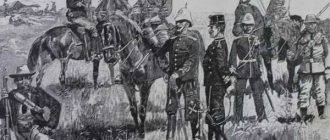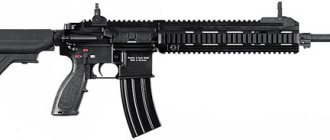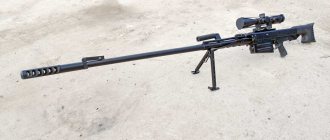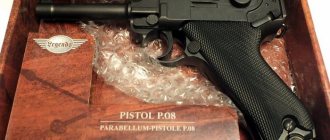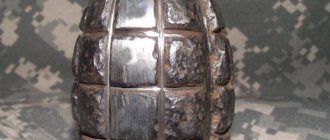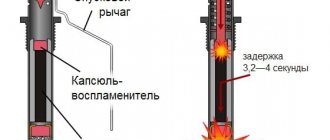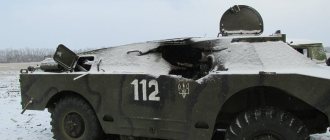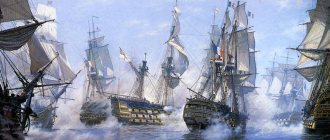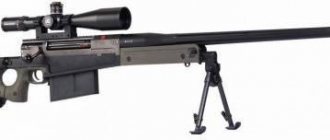The Lee-Metford rifle, adopted by the British Army in 1888, was distinguished by rather mediocre shooting parameters. But at the same time, the bolt group and high-capacity magazine of Lee's design ensured fast reloading and a high practical rate of fire.
After changing the cartridge, and this happened in 1895, an improved rifle, the Lee-Enfield, model 1895, entered service with the British army. She also managed to make her mark in South Africa, but unlike her older brother (more like her sister - the rifle), she did not end up on the tip of Louis Boussenard’s pen in his “Rip-off.”
Most likely, it is from the nickname of the opponents of the English army that the roots of the nickname “Boer” grow - this was the name of the Dutch and German settlers of South Africa, who, with their Mausers and ancient muzzle-loading Roers and Martinis, inflicted considerable losses on the expeditionary force.
History of creation and modernization
James Paris Lee, the creator of the detachable permanent magazine and bolt group used in English rifles, was an outstanding designer and master of his craft.
Its design has proven its viability no worse than its younger sisters: the Mauser and Mosin rifles.
The Lee-Metford rifle adopted by the Royal Army, mod. 1888, chambered for 7.71 mm black powder, became obsolete in just five years.
Nitropowder was increasingly used in weapons; with their use, ballistics improved, and a cloud of smoke and soot was not created when fired.
But when using smokeless powder in cartridges, the rifling in the barrel quickly wore out in the Lee-Metfords, and the ballistics of the bullet were very mediocre.
Therefore, already in 1895, the Lee-Enfield rifle was developed on its basis. The name is compound, from the designer - Lee, the second - Enfield (Enfield) the city in which the royal factory for the production of small arms was located.
The split stock, magazine and bolt design, and caliber (but not the cartridge) remained from the Lee-Metford, but the barrel changed. It (the Drill) was developed for a cartridge with smokeless powder and received 6 polygonal rifling, which provides the weapon with good ballistics. It was this model of weapon that became known to a wide circle of readers under the name Lee-Enfield, Bur-303 or simply the Bur rifle.
Notes
- ↑
- as noted in the report of the Estonian headquarters of the partisan movement No. 00643 dated December 3, 1943, “ The Germans began to put together the volunteer paramilitary organization Omakaitse from the first days of the occupation... all members of Omakaitse are armed predominantly with English rifles
” M. I. Semiryaga. Collaborationism. Nature, typology and manifestations during the Second World War. M., ROSSPEN, 2000. pp.837-841 - Martin Windrow, Mike Chappel. The French Indochina War 1946 – 54. London, Osprey Publishing Ltd., 1998. page 41
- Lt.-Gen. Prakash Katoch. Short-circuiting Carbines procurement for Army, but why not Assault Rifles? // “Indian Defense Review” from January 11, 2017
- “ Much of Burma's armed forces small arms inventory comes from the age of hard wood and cold steel.
With their armed forces dating back to 1948, equipped and supplied by the British Government, it is quite a common sight to see Lee Enfield No. 4 rifles… The Burmese Police Special Task Force still uses No. 4s today “V. Kenneth. The Old Timers of Burma // “Small Arms Review”, September 2012 - Chinua Achebe. Girls at war. // Selected works of writers of Tropical Africa. M., 1979
- G. V. Shubin. What small arms is Africa fighting with? // “Asia and Africa today”, No. 3, March 2011. p.61-62
Not for war, but for punitive operations of colonial troops
The .303 British cartridge is known in metric measurement as 7.71x56R. It is interesting that until 1899, before Britain signed the Hague Convention, the enlightened and civilized British mass produced cartridges with hollow-point bullets, as they are also called “dum-dum”. This was explained by the fact that these bullets were very good for the war with the “savages”.
Mk.II, III, IV and V these cartridges were produced for the war with the aborigines and had hollow-point bullets developed by Berthier Clay from the Dum-Dum arsenal in India. Mk.VI received a jacketed bullet with a spherical tip, but this cartridge was produced for only 6 years, from 1904 to 1906.
In 1910, a cartridge with the Mk.VII bullet was adopted, which, thanks to its lightweight aluminum or bakelite tip, caused wounds no worse than hollow-point bullets of earlier releases. Due to the instability of the balancing of the bullet, when it hit obstacles, it began to twist and turn.
7.71x56R had modifications with armor-piercing, incendiary and tracer bullets. The same cartridge was used in machine guns used by the British Army.
Ammunition nomenclature
Here you can take a closer look at the design of the clip
All modifications were equipped with the standard British cartridge .303 British (7.69*56 mm R or 7.7*56 mm R - the designation changed with the use of deeper barrel rifling in the main British rifle).
The table below shows all types of cartridges, up to the mid-twentieth century:
| Name | Year of adoption | Note |
| Mk.III | 1898 | Semi-jacketed bullet - removed from service by decision of the Hague Convention of 1899 |
| Mk.IV | Unknown, probably 1898-1899 | Semi-jacketed bullet - removed from service by decision of the Hague Convention of 1899 |
| Mk.VI | 1904 | Basic cartridge |
| Mk.VII | 1910 | The pointed bullet of this ammunition provided a lethal effect close to that of prohibited cartridges |
| Mk.VII.Y | 1916 | Explosive cartridge |
| BIK Mk.VII.K | 1916 | Incendiary cartridge |
| Mk.VIII | 1938 | A pointed bullet, and an increased weight of gunpowder compared to its predecessors |
| B Mk 7 | 1942 | Incendiary bullet |
| W Mk 1Z | 1945 | Armor-piercing bullet |
A few words about semi-jacketed bullets. British troops used them in the development of new colonies and during military campaigns to suppress national uprisings in already captured territories. Such a bullet received the nickname “dum-dum” in honor of the place name in India, where the first (or one of the first) mass use of such ammunition was noted. Once in the body, it bursts and begins to “tumble,” causing terrible wounds that were impossible to cope with at the level of medicine even in European countries and the United States, not to mention African tribes or the population of India and southeast Asia. They were soon banned by the decision of the convention on the “modern face of war.”
Rifle design
The Lee-Enfield bolt group, like its predecessor, is another variation of the widely used longitudinally sliding bolt, which became widespread at the turn of the 19th and 20th centuries.
In order to reload the rifle, it is enough to turn the bolt up, unlock it with the barrel and move it towards you, at this time the ejector pulls the spent cartridge case out of the chamber and cocks the hammer.
After this, when the bolt stem moves forward, a cartridge from the magazine is sent into the chamber and the weapon is ready to fire.
In the Lee-Enfield, the charging handle is located close to the rear of the bolt, which is much more convenient when reloading, unlike, for example, the Mosin carbine, in which the charging handle is offset to the center. This made it possible to achieve a high practical rate of fire.
Reloading can be done with one hand, without taking the shooter away from aiming. This is impossible with Mosin or Mauser rifles, in which the bolt stem (if you try to reload in this way) will leave a beautiful bruise under the shooter's eye.
The magazine is detachable, but at the same time it is removed only for cleaning and lubrication. The rifle is reloaded using clips from above, with the bolt open, through the feeder window. The clips are standard, holding 5 rounds; two clips are used for reloading, since the magazine capacity is 10 rounds.
Until 1916, the SMLE (Short Magazine Lee-Enfield) design used some technical solutions from the 19th century. They are still interesting now:
- Sights for volley fire or firing in bursts. They consisted of a diopter rear sight and a front sight located on the left side of the stock. Volley fire was used to suppress the enemy at long range;
- A detachable magazine without the possibility of its separate equipment is a rather strange design solution;
- Split stock, unjustified complication of the rifle design;
- Magazine cut-off, when the magazine is full, it can be disconnected from the feed and loaded one cartridge at a time, placing it in front of the bolt. This method was used to save ammo during harassing shooting by firing one round at a time without expending the magazine.
Despite some “interesting or oddities” in the design of the weapon, the Lee-Enfield was a fairly effective and reliable weapon.
Lee-Enfield 1904 – Wikipedia
Material from Wikipedia - the free encyclopedia
| Lee-Enfield No.1 Mk3 |
| magazine rifle |
| UK UK |
| 1902 - present day |
| 1895 |
| Great Britain, British Colonies, Thailand, Canada |
| World War I, World War II, Korean War, etc. |
| (English) |
| 1896 |
| (English) (UK), (English) (India), USA, Canada |
| 1907-1975 |
| ~17 million |
| 3,9 |
| 1130 |
| 635 |
| .303 Mk VII SAA Ball |
| 7,7 |
| manual reloading, bolt action |
| 20—30 |
| 744 |
| 914 |
| 1829 |
| detachable 10-round magazine, loaded with 5-round clips |
| Lee-Enfield |
Lee Enfield is a family of British rifles.
Modifications
After the Anglo-Boer War of 1899-1900, the British generals, I think, were one of the first to realize that long rifles for arming infantry and Lee-Metford and Lee-Enfield carbines were not exactly what was required for modern warfare.
As a result, the Short Magazine Lee-Enfield Mk I was adopted, which meant a short magazine / rifle / Lee-Enfield, the first model. Compared to the carbine, it had an increased length, but at the same time was shorter than standard army rifles - Magazine Lee-Enfield Mk.I.
During modernization, everything unnecessary was cut off from the weapon, its design was simplified, and manufacturability increased.
In 1907, the SMLE model 3 appeared, which at that time had an optimal layout, reliability, and at the same time its production was simplified as much as possible. With these weapons, Great Britain entered the First World War.
In the trenches of the First World War, Lee-Enfield proved himself above all praise. Convenient layout, rear-mounted bolt handle and reliability quickly gained popularity and love among soldiers.
But at the same time, complaints also appeared, mainly of an economic nature - the rifle was poorly suited to the role of a cheap, high-tech weapon. But, despite this, SMLE No. 3 remained the main weapon of the British infantry, moreover, almost all dominions adopted this particular weapon.
After the end of the war, already in 1931, the 4th model of the shortened Lee-Enfield rifle, model No. 4, was adopted for service; it differed from earlier models in a heavier barrel, an elongated sighting line due to the transfer of the rear sight to the receiver, slightly simplified mechanisms and a shortened butt.
On the basis of this rifle, a sniper model was developed - SMLE No. 4 Mk.I (T); it was distinguished from the base model by the presence of a bracket for mounting an optical sight and a higher quality barrel. Unfortunately, we had to abandon loading it with clips; we had to reload it by inserting one cartridge at a time into the receiver window.
The next mass model of SMLE was the Rifle No 5 Mk I “Jungle Carbine”, once again a shortened carbine.
It was intended for operations in the jungle, where the large length of a rifle or carbine makes life difficult for the shooter.
This time a miracle did not happen, the weapon, reduced to the dimensions of an intermediate-caliber carbine and chambered for a rifle cartridge, stunned and blinded its owner when fired, the conical flame arrester introduced by the designers did not save the shooter from the flash.
The last attempt to revive it in our time was an attempt to mass produce the Rifle 7.62mm 2A1, the good old Lee-Enfield in plastic and with a new barrel, for use by Canadian rangers and police. But this weapon did not become widespread; the time of repeating carbines was gone, and the SMLE did not perform very well as a sniper rifle.
It is worth noting another modification of Lee-Enfield, little known today, this is an Indian carbine chambered for .410 caliber with a smooth barrel. With this, the British authorities armed the local police. The Aborigines had always been less well armed than the colonial troops, but with this type of weaponry the British outdid even themselves.
Design[edit | edit source]
The Lee-Enfield rifle is a bolt-action magazine-fed rifle.
The barrel rifling of the Lee-Metford used a Metford pattern polygonal rifling with shallow groves, intended to be used with ammunition loaded with black powder. The polygonal rifling was intended to produce tighter tolerances and easier cleaning, with less fouling. Introduction of the smokeless powders in the form of the Cordite showed that the Metford rifling had a short service life, so it was soon replaced with Enfield rifling, with 5 traditional land and grooves and left hand pitch.
magazineedit | edit source
The magazine designed by James Paris Lee is a distinctive feature of the Lee-Enfield. It holds 10 rounds of ammunition in a double stacked magazine.
The magazine is detachable, but the rifle is not intended to be reloaded by replacing the magazine, but by two charger clips each holding five rounds of .303 ammunition. Early Lee-Enfields (Long Lee-Enfields and SMLEs prior to MkIII) were loaded only by single rounds via the top receiver opening. Latter, the clip (charger) loading was introduced, and a rear receiver bridge with charger clip guides was added to the design. Some of the earlier marks were then retrofitted with charger loading ability during 1907-1910.
Prior to the 1916, all SMLEs (and earlier Long Lee-Enfields) were issued with so called “magazine cut-off” – a device located at the right side of the receiver, which would cut off the cartridge supply from magazine to the action when engaged, effectively turning the rifle into a single-shot rifle. This was an outdated idea even when it was first introduced, so it was easily discarded when the need to speed up production arose.
The magazine itself should be detached only for cleaning, maintenance and repair, and every rifle was issued with only one magazine. The magazine catch is located inside the trigger guard.
Actionedit | edit source
The bolt action, also invented by James Paris Lee, is another distinctive feature of the Lee-Enfield. The rotating bolt has two lugs that lock into the receiver walls at the rear part of the bolt, thus saving some part of the bolt length and bolt pull, when comparing to the forward lugs locking. This shorter bolt pull, along with charging handle, located at the rear part of the bolt and bent down, ribbon itself to quick reloading, not to mention the above average ten rounds in a magazine.
The SMLE was a striker fired gun, with cocking on the bolt close action and a dual-stage trigger. The bolt head with the extractor was a separate, non-rotating unit, screwed into the bolt body. The safety was located at the rear left side of the receiver and was easily turned rearward 160 by the thumb on the shooter's firing hand, which would not only lock the trigger, but the bolt as well.
One notable feature of the Lee bolt action was that the bolts were not interchangeable between different rifles of the same mark. Each bolt must be tailored to its respective action, thus making the production and in-field bolt replacement more complicated. The insufficient headspace problem on the pre-No.4 SMLEs was solved by manual sandpapering the respective bolt-head, and since the introduction of the No.4 rifle, there were 4 standard sizes of bolt heads, from which armorer could select one, most suitable for the particular action.
Stockedit | edit source
The Lee-Enfield stock features a semi-pistol grip, steel buttplate with a trap door (for maintenance/cleaning tools) and a nose cap over the fore-end of the stock near the muzzle, which often featured a bayonet lug under it, until the No.4 rifle, where it was moved onto the barrel itself. Sling mounting swivels were most often placed underneath the forward handguard's barrel band and in the traditional location of underneath the buttstock.
Combat use
The Lee-Enfield was first tested in the Transvaal; the Boer War affected the rifle's career only with the appearance of the nickname "Boer". Otherwise, this war did not show anything interesting. Due to the peculiarities of the landscape and the combat operations themselves, the weapon did not experience any special stress; it is difficult to call this period of the life of the Lee-Enfield rifle a full-fledged testing.
The real test for her was the First World War, here British weapons showed themselves at their best.
The SMLE rifle was a reliable and accurate weapon; moreover, the larger magazine capacity compared to its competitors gave British shooters a greater chance of survival.
During the same period of time, the Lee-Enfields also entered Afghanistan; in 1919, Afghan soldiers crossed the border and stormed the city of Bagh. The forces of the British colonial corps and battalions of Gurkhas and sepoys of Indian troops were brought into Afghanistan.
They were armed with SMLE No. 3 rifles, during the battles the British restored justice, dispersed the troops of Nadir Khan, after which a peace agreement was signed in August 1919. True, it is worth noting that the losses of the British and Indians were twice as high as the losses of the Afghans, but over 50% of the losses can be attributed to sanitary losses.
After this conflict, the first Bur-303 rifles appeared in Afghanistan, in addition, some were received from India and Pakistan subsequently; the arms market after the First World War was oversaturated with rifles and machine guns. The cartridges for them were produced in the Royal Arsenal of Afghanistan. There is information about independent reloading of cartridges outside the arsenal.
The fact is that as a result of this conflict, the legend of the Afghan “Wunder Waffe” was born - the famous and legendary “Bur” rifle that penetrates armored vehicles right through, and Pashtun super-snipers fired from this “Shuravi” Drill at a distance of a couple of kilometers.
I have to disappoint the discerning reader. The “Boer” really existed, moreover, some of the Pashtuns really proudly wore this masterpiece of English weapons thought. But one could only dream of an accurate shot a couple of kilometers away or of penetrating the armor of a tank or infantry fighting vehicle.
The ballistic characteristics of the 7.71x56R cartridge are similar to those from the Mosin rifle or SVD. The 7.62x54R cartridge is almost no different in its characteristics from the British one.
With the same success, the German 7.92 mm Mauser cartridge could appear in the role of .303 British; its power, by the way, is slightly higher than that of its British or Russian counterpart. Moreover, standard bullets from the British cartridge were designed to shoot “Papuans” (a lightweight bullet with a light tip); such a cartridge could not penetrate the armor of an armored personnel carrier.
Another conversation is about cartridges with armor-piercing or armor-piercing incendiary bullets, which could well have been produced in Afghanistan. Their characteristics are quite comparable to armor-piercing bullets fired from an SVD sniper rifle and can easily penetrate the armor of light armored vehicles.
There is no point in talking about the characteristics of the “drill” in comparison with special weapons such as VSS or KSVK rifles; they occupy too different niches. It’s difficult to talk about the great masters of sniping, with rifles produced at the beginning of the century, or even using SMLE No. 4, from the 40s of the last century.
With prolonged and intensive use of weapons, even with periodic maintenance, the barrels wear out, and there is no need to talk about any kind of accurate shooting at extreme distances.
According to modern shooting of the Lee Enfield No4.Mk2(F) rifle manufactured in 1954, at 100 meters the hits fell in a circle no more than 14 mm in diameter. But in this case, the shooting was carried out with targeted cartridges and an excellent shooter.
Lee Enfield rifles were officially in service with the British Army until the 50s of the last century. However, the quantity produced (6 million pieces) was more than enough for their use in later conflicts, including the Afghan War of 1979-1989.
Only now she was already shooting at other “shuravi”, fighting on the side of the dushmans. To this day it can be found in local conflicts, although its time, of course, is long gone and irrevocably gone. However, more than a hundred years of history of the use of this rifle speaks of the genius of its inventor. Time flies quickly and most likely, in ten years, Boer will be found, well, perhaps in museums.
Breda-SAFAT, Italy
In the previous article we talked briefly about the 7.7 mm machine gun of this bicaliber family. Criticizing. So, that machine gun was GOOD! We won’t say the same about its large-caliber brother.
If the 7.7 mm rifle cartridge in terms of muzzle energy was not very different from any other classmates, then the Italians’ choice of ammunition will puzzle anyone, let alone non-experts.
British cartridge 0.50 from Vickers. A very weak cartridge. One might even say, the weakest in the world. Why Mussolini, who was in charge of armaments, rejected the heavier French Hotchkiss cartridge is anyone's guess. But the French cartridge was one and a half times heavier and had more acceptable characteristics. Perhaps this has something to do with the eternal Franco-Italian confrontation.
The only advantage of the Breda machine gun was the presence of explosive cartridges prohibited by international treaty, the 37-gram shells of which contained 0.8 grams of pentrite.
By the way, in some sources the Breda-SAFAT 12.7 mm machine guns are presented almost as copies of the Browning. It’s difficult to say why people do this, but the fact is that although there are some common features in the appearance of machine guns, Breda’s machine gun was very, very far from Browning’s creation.
"Breda-SAFAT" was inferior to "Browning" in absolutely all characteristics. The Italian cartridge 12.7x81SR is expectedly less powerful than the American 12.7x99. And this entailed a decrease in muzzle energy, sighting range, and even the Italian machine gun was not very fast-firing. And in the synchronized version, the machine gun’s rate of fire dropped from 700 to 450-550 rounds per minute, which was no good at all.
But since there were no other machine guns (Scotty’s product does not count), the Breda-SAFAT was installed on everything that took off under the Italian sign. With expectedly incomprehensible results.
Pros: reliable.
Disadvantages: rate of fire, frankly weak cartridge with low ballistics.
Special Variants[edit | edit source]
De Lisle carbineedit | edit source
Main article: De Lisle carbine
The De Lisle carbine is a suppressed carbine chambered in .45 ACP based on the Lee-Enfield Mk III*. It was made in very limited numbers, and was used by British special forces during World War II and the Malayan Emergency.
Howell Automatic Rifleedit | edit source
Main article: Howell Automatic Rifle
The Howell Automatic Rifle was the first attempt to convert the Lee-Enfield into a semi-automatic rifle, designed during or after World War I.
Charlton automatic rifleedit | edit source
Main article: Charlton automatic rifle
The Charlton Automatic Rifle was a fully automatic conversion of the Lee-Enfield rifle, designed by New Zealander Philip Charlton in 1941. The original Charlton Automatic Rifles were converted from obsolete Lee-Metford and Magazine Lee-Enfield rifles dating from as early as the Boer War.
A prototype Australian version with a different external appearance was made by Australian company Electrolux, using the SMLE Mk III* for conversion.
Rieder automatic rifleedit | edit source
Main article: Rieder automatic rifle
The Rieder Automatic Rifle was a semi-automatic Lee-Enfield conversion of South African origin. The Rieder device could be installed straight away without the use of tools.
How it all began?
this is a weapon
The British had to urgently develop a new barrel with a different rifling configuration. Of course, the sighting devices have also undergone modifications. The new Lee-Enfield fully proved its “professional suitability” during the bloody Anglo-Boer Wars.
If you read adventure novels as a child, then you probably remember about “drills” and “fittings” that made it possible to hit the enemy from distances that were prohibitive at that time. As a matter of fact, in most cases it was just about the English “Lee-Enfield”, since the Boers (Dutch colonists) used mainly German “Mausers”.
Optional equipment
Sights include a SUSAT 4X optical sight. The sight provides accurate shooting at a distance of 500 meters and even further, and on its upper surface there are a reserve front sight and a diopter rear sight. As a cheaper alternative to the SUSAT sight, the L85 rifles are equipped with removable open sights consisting of a front sight on a high base and a removable carrying handle with a built-in diopter rear sight. The rifles are also equipped with a rifle belt for carrying and a removable bayonet. In the L85A2 variant, it is possible to install an under-barrel grenade launcher with a 40mm caliber produced by the German company Heckler-Koch. A special forend is used to install the grenade launcher.
In recent years, the rifle has undergone a number of external changes. The units now have more convenient and versatile RIS handguards, to which handles, tactical flashlights (LLM01) and other additional equipment can be easily mounted. The old SUSAT optical sight was replaced by the ACOG sight (Trijicon), which has better optical characteristics and is quite popular among the troops of NATO countries.
Daniel Defense promotional video about the RIS handguard on the L85
Review of L85 in the program “Military Affairs”
"Bur-303" - a legendary rifle that has never existed in nature
“This little thing of mine will still serve well,” Hugo said, walking around his heavy “Drill.” “She will drive more than one English eye into a skull, mark my words...”
Louis Boussinard, "Captain Rip-Off"
"Bur-303" ... Lethal force be healthy, it could make a hole in an armored personnel carrier"
“Due to the high air vacuum, the AK-74 showed completely unsatisfactory dispersion indicators. The military was perplexed: why was the costly rearmament necessary? In addition, Southerners have a lower pain threshold and the AK-74 was less effective than the AKM. The Afghans, who were armed with Boers, could shoot effectively at a long distance... They had to use Mosin rifles taken from warehouses.”
Sniper rifle Lee-Enfield Rifle No.4 (T) (UK)
No.4 Mk I (T)
In 1941, the Rifle No.4 Mk I repeating rifle of .303 caliber was officially adopted by the British Army, which became the main weapon of the British in World War II.
View of the brackets for the optical sight
In 1942, due to a shortage of sniper weapons at the front, it was decided to use the No.4 Mk I and No.4 Mk I* models as sniper rifles (they differed mainly in mechanical sighting devices). For this purpose, samples were selected from the batch of rifles No. 4 that showed the best results when shooting; brackets were installed on their receiver on the left on which an optical sight was attached, and the butt received a wooden cheek rest.
The modified rifles were designated “Rifle No.4 Mk I (T)” and “Rifle No.4 Mk I* (T)” (the letter “T” stands for “Telescopic Sight”) and began arriving in February 1942 into service with the British Army.
No.4 Mk I (T) without optical sight
Structurally, the Model No.4 (T) sniper rifle was a manually reloading repeating rifle with a bolt action design by Lee, an improvement on the Enfield Arsenal.
View of the optical sight and controls No.4 Mk I (T)
The bolt handle is located at the rear of the bolt and is curved down. The bolt was locked by two lugs in its rear part, which fit into the cutouts of the receiver. The bolt had a fixed combat cylinder screwed into its body with a protrusion in the front part on the right, in which the extractor tooth was located.
The trigger mechanism mounted in the bolt is striker-fired. The descent is two-stage, with a warning. The firing pin was cocked when the bolt was closed.
The safety in the form of a rotary lever is located on the left side of the receiver, in its rear part, and was conveniently controlled with the thumb of the right hand without changing the grip and grip of the weapon.
View of the optical sight and controls No.4 Mk I (T)
The weapon was fed with ammunition from a detachable box-shaped double-row magazine with a capacity of 10 rounds, arranged in a checkerboard pattern. The magazine was loaded through the top window in the receiver with the bolt open, one cartridge at a time or from 5-round clips. The guides for the clips are made in the form of a special “bridge” in the rear part of the receiver. In this case, the magazine could only be equipped when attached to the weapon, and was detached only for cleaning, maintenance and repair. The magazine latch is located inside the trigger guard.
Mechanical sights of the open type consisted of a ring sight and a front sight. The Mk I model had a flip-up diopter rear sight with divisions from 200 to 1300 yards (182 - 1189 m) and elevation adjustment, and the Mk I* model had a two-position L-shaped flip-up non-adjustable diopter rear sight at 2 ranges - 300 and 600 yards (274 and 549 meters). The rectangular front sight is protected from external damage by “wings”.
| Caliber, mm | 7.7×56 R(.303) |
| Length, mm | 1129 |
| Barrel length, mm | 640 |
| Weight without cartridges and optics, kg | 4.11 |
| Store, count. cartridges | 10 |
| Initial bullet speed, m/s | 745 |
| Effective firing range, m | 600 |
Optical sighting devices, as a rule, were a telescopic sight with 3x magnification, which was mounted on the receiver.
The durable stock consisted of a butt and fore-end. The butt had a straight neck, in the rear part turning into a weakly defined semi-pistol grip, and was attached to the receiver with a long, strong longitudinal screw passing from the butt plate to the receiver shield. The butt had a brass butt plate with a door that closed the compartment for accessories, and for ease of aiming it was equipped with a wooden cheek. The forend and the two-piece receiver lining were fastened with two sliding rings.
The rifle did not have a cleaning rod. To clean and lubricate the bore, a rope wipe carried in the butt was used.
During the entire production of this weapon, about 27,000 sniper rifles of the No.4 (T) model were produced.
These rifles were widely used not only during World War II, but also in various military conflicts until the late 1960s, when the British Army switched to the 7.62x51mm NATO cartridge. In the 1970s, most of the No.4 (T) model sniper rifles, along with the No.4 rifles, were converted into L42A1 sniper rifles in 7.62 mm caliber.
No.4 Mk I (T)
Operators
Parade of a detachment of “French militia” armed with Lee-Enfield rifles and Bren machine guns
Great Britain Great Britain: adopted by the British Empire, including the dominions and colonies, was in service until the 1950s, when it was replaced by the L1A1 self-loading rifle.
- Canada Canada: in service since 1916, after 1947 transferred to mobilization reserve warehouses, until 2014 was in service with the Canadian Rangers
- Australia Australia
- New Zealand New Zealand
- Ireland Ireland: used during the War of Independence, after which the rifles remained in service with the Irish Army
- Italy Italy: some were obtained during the First World War; At the end of World War II, after the surrender of Italy in the fall of 1943, the rifles were received under the military aid program, they were used in the navy and then transferred to mobilization reserve warehouses. Removed from service in 2005
- Lithuania Lithuania: in 1924, a batch of rifles and ammunition for them was purchased from Italy
- Germany Germany: during the Second World War, captured rifles entered service with auxiliary paramilitary forces: Lee-Enfield No.1 Mk.III - under the name Gewehr 281 (e)
, Lee-Enfield No.3 Mk.I rifles - under the name
Gewehr 282(e)
and Lee-Enfield No.4 Mk.I rifles - under the name
Gewehr 283(e)
. In particular, they were armed with units of the “French police” and a significant part of the personnel of the “Omakaitse” detachments in the occupied territory of Estonia. - France France: During World War II, used by Free French forces. Also used during the Indochina War by members of the French troops in Indochina and were subsequently transferred by the French military command to colonial troops and Vietnamese units.
- India India: After the partition of British India in 1947, British Indian Army rifles entered service with the Indian Army. In 2008, the command of the Indian Army decided to replace the rifles with more modern weapons, but in 2017 they still remained in service.
- Pakistan Pakistan: after the declaration of independence of Pakistan in 1947, rifles entered service with the Pakistan Army
- Israel Israel: a number of rifles were at the disposal of Jewish armed forces in Palestine even before the proclamation of the State of Israel, and they were later used during the War of Independence
- Myanmar Myanmar: After the declaration of independence of Burma in January 1948, Lee-Enfield No.4 rifles remained in service with the army and police. Despite the replacement of these rifles in the active army with HK G.3 assault rifles, the rifles are used for initial shooting training of military personnel and are stored in mobilization reserve warehouses, and are also in service with the police
- Federal Republic of Germany - after the creation of the Bundeswehr, a number of Enfield No.4 Mk.I rifles received under the military assistance program from Great Britain entered service with the Bundeswehr under the name G61
- Nigeria Nigeria: After the declaration of independence of Nigeria in 1960, Mk.4 rifles, previously in service with the colonial police, remained in service with the Nigerian police
In former British colonies, Asia and Africa, Lee-Enfield rifles were used for decades after the end of World War II.
As of early 2011, a significant number of rifles (mostly supplied in the post-World War II period) were still in use by armed paramilitaries in Africa.
USA
Browning M1919 machine gun
The M1919A4 was produced mainly for infantry and proved to be a first-class heavy machine gun, with a high rate of fire and without any particular complaints or problems. The tank version was designated M1919A5; the M2 modification was developed for the Air Force (installed on both fighters and bombers - on turrets).
The US Navy received the AN-M2 machine gun, developed on the basis of the M1919A4. Thus, over the long production period, many modifications and production changes appeared, but the basic design of the M1919 remained unchanged. The cartridges were fed using a cloth or metal tape. In the infantry, a machine gun was usually mounted on a simple tripod machine, but there were a great variety of machines, including quite complex ones for anti-aircraft installations and simple mounts for installation on various types of wheeled vehicles.
Light machine gun
Perhaps the strangest modification of the M1919 was the M1919A6. It was designed as a light machine gun to enhance squad firepower to replace the BAR machine gun. This model was introduced in 1943 and was an M191A4 with a strange shoulder rest, bipod, carrying handle and a lightweight barrel. The result was a machine gun that was quite heavy for a hand gun, but easy to manufacture.
The disadvantages were the general awkwardness of the weapon and the need to use gloves to change the barrel. Despite this, the M1919 was produced in large quantities (a total of 43,479 units were produced). The troops were forced to use it, realizing that it copes with its task better than BAR. The main value of all models of this machine gun was its reliability: they remained operational even in the most unfavorable conditions, when almost all other models (except, perhaps, the Vickers) failed.
Browning M1919 machine gun characteristics:
- Browning M1919A4 machine gun
- Caliber - 7.62 mm
- Weight: 14.06 kg
- Overall length: 1041 mm
- Barrel length: 610 mm
- Initial bullet speed: 854 m/s
- Rate of fire: 400 - 500 rounds/min
- Food: fabric or metal tape, 250 rounds
Browning M1919A6 machine gun
- Caliber: 7.62 mm
- Weight: 14.74 kg
- Overall length: 1346 mm
- Barrel length: 610 mm
- Initial bullet speed: 854 m/s
- Rate of fire: 400 - 500 rounds. /min
- Food: fabric or metal tape, 250 rounds
Why did the soldiers like the weapon so much?
Despite some technological sophistication, the British managed to create an extremely reliable weapon. There are known cases when soldiers wrapped the bolt with oily rags, after which they continued to fight, even while lying in the water of the trenches. In conditions of constant shelling from large guns, when the entire contents of the trenches were covered with a thick layer of mud and sand, the reliability of these rifles was simply a gift from above.
The appearance of the "Bur" hand grenade launcher
The history of the appearance of the Bur grenade launcher, which is the lightest grenade launcher in the world, began at the Tula Instrument Design Bureau. This compact model of a hand grenade launcher was created on the basis of the RPO-PDM-A Shmel flamethrower. This weapon, which has gone through more than one military conflict, has proven itself to be reliable and trouble-free, although the army constantly complained about its excess weight and dimensions.
The designers set themselves the task of achieving a significant reduction in the weight and dimensions of the new weapon, while maintaining power. Having started to develop a new model of weapon, Tula designers were able to quickly produce the Bur grenade launcher, the weight and dimensions of which made this weapon unique of its kind. There is still no weapon in this class in the world that could surpass the Bur MGK.
The first prototype of the Bur grenade launcher was demonstrated in 2013 at the specialized exhibition Interpolitech. The new portable grenade launcher created a sensation among the military, especially when they learned about the simplicity of the grenade launcher's design, which made it possible to launch its mass production in record time. A year later, the small-sized Bur grenade launcher was presented at an international arms exhibition as a production model.
"Bur" is not just a modernized weapon. In addition to the fact that during its creation the best solutions used in the production of rocket-propelled grenade launchers of previous generations were used, various innovative ideas were also taken into account. The combination of proven and innovative technologies made it possible to achieve the following parameters of the Bur grenade launcher:
- The weight of the weapon was only 4.8 kg. For comparison, the weight of the Bumblebee flamethrower is 10 kg;
- The length of the Bur grenade launcher is 742 mm.
Unlike the Shmel flamethrower, which was disposable, the Bur grenade launcher can be used repeatedly. More precisely, the launching device is reused, and the transport and launch container is changed. The launcher can be equipped with a special sighting device. Due to the possibility of repeated use, the use of a sighting device of this type in the design of the Bur grenade launcher has become cost-effective.
Tool selection criteria
When purchasing a hand-held garden auger, it is important to focus on its compliance with the following characteristics:
Drilling depth. Here it is better to give preference to a tool with maximum capabilities. Even if you need to drill a small hole at the moment, this does not mean that in a few years you will not need a drill to make deeper holes.
The diameter of the resulting hole. In everyday conditions, a tool capable of producing holes of 20–30 cm is sufficient. A thin mechanical drill is easier to work with. Ideally, have 2 types of tools to first make a small hole and then widen it.
Tool weight. A hand drill has to be carried on your hands, so you should give preference to lightweight models. However, you should avoid purchasing drills that are too light. They are made of the thinnest steel, which is easily deformed during use. The optimal weight of a hand tool is from 2 to 6 kg.
Comfortable handle. This criterion is especially important. If the tube on the handle is too thin, you will have to exert significant effort while working, and this can cause pain and excessive fatigue.
It is also important that the handles of the tool are smooth, since the textured surface will rub your palms.
